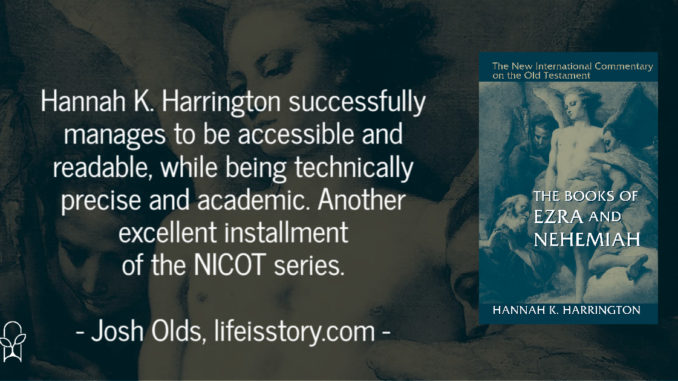
Series: New International Commentaries
Published by Eerdmans on May 31, 2022
Genres: Academic, Non-Fiction
Buy on Amazon
Goodreads

The books of Ezra and Nehemiah represent a significant turning point in biblical history. They tell the story not only of the rebuilding of the temple in Jerusalem but also of the resurrection of God’s people from the death of exile. Hannah Harrington thus begins her commentary with an evocative description of these books as “the story of a new Israel forged out of the old” and “the text of a people clinging to their genealogical past and attempting to preserve their heritage while walking forward into uncharted territory.”
Throughout this commentary, Harrington combines analytical research on the language and culture behind the books of Ezra and Nehemiah with challenging thoughts for the Christian church today, bringing to bear a unique perspective on these books not as the end of Old Testament history but as early documents of the Second Temple period. Accordingly, Harrington incorporates a wealth of information from other Jewish literature of the time to freshly illuminate many of the topics and issues at hand while focusing on the interpretation and use of these books for Christian life today.
Like several of the recent New International Commentary releases, Hannah K. Harrington’s The Books of Ezra and Nehemiah replaces an older volume on those books in the series, offering a more in-depth analysis with updated scholarship. This book replaces the 1982 volume by the late F. Charles Fensham, providing a necessary update on the scholarship of these two important books.
Harrington is perhaps best known for her work with the Dead Sea Scrolls, having written extensively on them and other topics relating to Second Temple Judaism. Her academic background is Near Eastern Studies and she currently serves as Professor of Old Testament at Patten University. It’s worth noting that Harrington is the third woman to be featured as an author of a NICOT/NICNT text and the first to have solo authorship of a volume. (The first two being Nancy deClaisse-Walford and Beth LaNeel Tanner, who coauthored the volume on Psalms with Rolf A. Jacobson in 2014.) Given the difficulty that women have had breaking into the fields of theology, biblical studies, and pastorship—particularly in evangelical circles—this contribution also stands as an important marker moving evangelical scholarship toward gender inclusivity in academia.
Harrington’s introduction to Ezra/Nehemiah comprises the first hundred pages of the book as she discusses issues pertaining to the text’s sources, canonicity, date, setting, and application. Within this section, the greatest amount of time is spent exploring the historical context of Persian rule and the beginnings of Second Temple Judaism. Ezra/Nehemiah chronologically represents the end of the Old Testament time period, taking place as the nation is returning from Babylonian captivity and rebuilding. As such, Harrington’s expertise in Second Temple Judaism informs her research and brings a depth of cultural context to the text.
A lot of this cultural context is explained even further in excurses located throughout the book. These sections are a wealth of content that break from a strict exegetical overview of the text to talk about the cultural aspects at play. These alone are worth the price of the commentary and are the book’s greatest strength. I particularly appreciated the excursus on the Jubilee and Sabbatical years and the sacrilege of intermarriage within Second Temple Judaism. These sections help readers understand what’s going on in the text by explaining things that the text’s original readers would have known intuitively, being within the culture.
The primary structure of The Books of Ezra and Nehemiah follows the typical NICOT/NICNT structure. The text is outlined thoroughly, introduced with an author’s translation of the text, and followed by a verse-by-verse exegesis. This structure helps the reader not get lost in the text and focus on both the particularities of a single verse and its larger context.
Theologically, Ezra/Nehemiah sets the stage for rabbinic Judaism, which is in full force by the days of Jesus. Thus, understanding Ezra/Nehemiah helps readers understand the cultural and religious context of the New Testament. Harrington’s expertise in this time period and within the Qumran community helps readers tie these two timeframes together and understand the whole scope of biblical history in greater detail.
The Books of Ezra and Nehemiah is yet another excellent installment updating the New International Commentaries on the Old Testament series. Harrington manages to be accessible and readable, but also technically precise and academic. This volume is perfect for clergy wanting to preach over these books but whose own academic study on them is lacking. Readers can clearly see how the story of Ezra/Nehemiah and the regathered people of Israel remains relevant and applicational for today.
